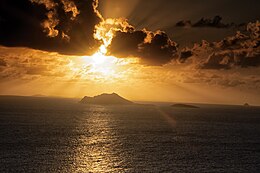 Saba Island (left) and Turtledove Cay (right) Saba Island (left) and Turtledove Cay (right) | |
  | |
| Geography | |
|---|---|
| Location | Caribbean Sea |
| Coordinates | 18°18′20″N 65°00′03″W / 18.30556°N 65.00083°W / 18.30556; -65.00083 |
| Administration | |
| Federal Department | U.S. Department of the Interior |
| Federal Agency | U.S. Fish and Wildlife Service |
Saba Island is a rocky Caribbean island in the United States Virgin Islands, situated three miles south of Cyril E. King Airport on St. Thomas and 2.6 miles west of Water Island. It is a steep, 200 feet high island with a sandy beach on the northern side. Turtledove Cay is connected by a shallow sandbar. Saba Island has salt ponds on both the eastern and western sides, which is popular bird observation posts, and has numerous rocky cliffs with sea birds on its southern shores. Besides for bird observation, the island is visited by scuba divers and snorkelers. In addition to coral reefs, the waters here are home to numerous ship wrecks, such as the Witshoal II, Witconcrete II, Grainton, and Witservice IV.
Flora and fauna
The island has the archipelago's largest colonies of seabirds with more than 30,000 sooty terns. Other seabird species include bridled, sandwich, royal and roseate terns, brown noddies, laughing gulls, as well as red-billed and white-tailed tropicbirds. The island has been recognised as an Important Bird Area (IBA) by BirdLife International.
References
- Sullivan, Lynne (2001). Adventure Guide to the Virgin Islands. Hunter Publishing, Inc. Page 66. ISBN 9781556509070.
- Greenberg, Harriet and Douglas (2006). The US Virgin Islands Alive!. Hunter Publishing, Inc. Page 55. ISBN 9781588435842.
- Potter, Susanna Henighan (2013). Moon Virgin Islands. Avalon Travel. Page 52. ISBN 9781612383682.
- Nellis, David W. (2000). Puerto Rico & Virgin Islands Wildlife Viewing Guide. Falcon. Page 75. ISBN 9781560448365.
- "Saba Island and Cays". BirdLife Data Zone. BirdLife International. 2021. Retrieved 21 February 2021.